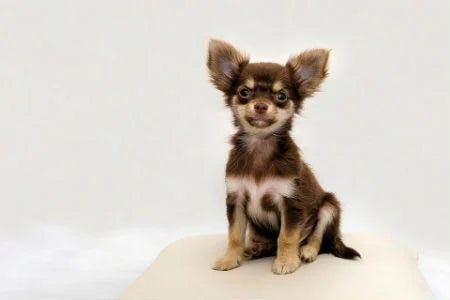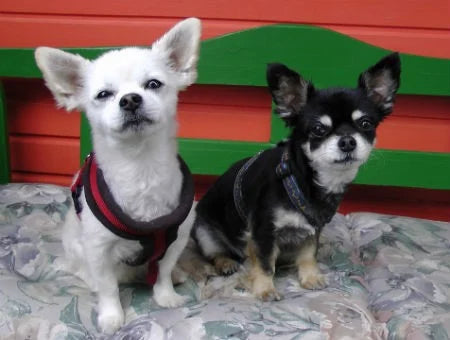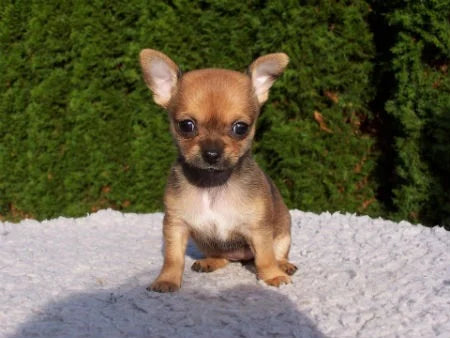- Size : Small.
- Weight : Between 1.5 and 3kg.
- Hair type : Short and straight
- Character : Devoted, Vivacious, Alert, Aggressive, Fast, Brave
- Health : Healthy
- Life expectancy : Between 12 and 20 years.
Where do Chihuahuas come from?
According to the genetic information analyzed by experts on the subject, there are several hypotheses about the origin of the Chihuahua breed because, throughout the history of the world, in its different periods, great changes and crossbreeding have occurred not only in humans. , but also in the different species of animals and plants. It is thought that this famous breed comes from Mexico mainly near the border with the United States, in the northwest of that country, in the state and city also called by that name.
What unique features do Chihuahuas have?
The Chihuahua, unlike other dogs, has certain characteristics that allow it to be recognized anywhere in the world , due to its physical appearance and the way it behaves. All this makes it quite peculiar, in addition to all these other features:- It is a small-sized canine : the smallest compared to other dog breeds, with approximate measurements between 15 cm to 30 cm in wingspan from head to tail, and height from 10 cm to 20 cm.
- It is one of the species that has the most colors in its fur : such as different shades of brown, from the darkest to the lightest; as with the color black and its chiaroscuro stages. There are also white and tricolor ones.
- They are temperamental and quite brave when it comes to confronting something that bothers them: be it a human or another animal, regardless of its size.
- They are agile and hyperkinetic dogs : Chihuahuas are easy to domesticate and train.
- It can, as long as you know how to raise it, live with different breeds of dogs or other pets.
- They have big eyes, a small mouth but with a strong bite, they are loving and jealous of their owners. However, we must not forget that they are dogs with admirable adaptability and intelligence .
- They can live an average of twenty years of age.
- They are naturally shaky and nervous dogs.
- The Chihuahua has an approximate weight of 3 kg.

- Apple head.
- Deer head.
Note : Its main difference is that the second is taller and thinner. Its head is like that of a deer. In addition, it is genetically healthier than applehead.
- Straight hair.
- Long hair.
Note: Its difference is that the second has longer, smoother fur and is internally hairier than the first, which may be more aesthetically pleasing to the human eye.
How should we feed our Chihuahua?
The main characteristic of Chihuahuas is that they are very small animals , therefore the Chihuahua's diet must be well planned, a balanced diet that allows this famous animal to be kept in the best conditions. His stomach is small, as are his teeth; and they are hyperkinetic, meaning they process their food much faster than other animals. Additionally, the food should be loaded with sufficient nutrients, proteins, minerals and carbohydrates. For this, there are certain dog foods from recognized brands that are responsible for making those croquettes that Chihuahuas love. These range from when they are puppies to their adulthood. You can also prepare a very healthy homemade delicacy for this type of breed. Leaving aside the feed, you can also prepare homemade food, but remember that any food source for this breed must be loaded mainly with a good amount of proteins such as: beef or chicken, always without salt, also of some lipids.
- Chocolates, cheeses, milk, onion, coffee, fermented doughs (such as bread), garlic, grapes, salt, alcohol, raw eggs, avocado, bones, ice cream, sugars and sweets in general, cat food, baby food, tobacco, raw fish, citrus fruits, etc.
How to maintain the health of the Chihuahua and what are the most common diseases?
To take care of the health of this small canine, in addition to everything indicated above about the diet that our Chihuahua should have , certain physiology and pathologies that can be found in these tender but reckless animals must be taken into consideration. Due to the peculiarity of its height, the Chihuahua is prone to being fragile in its bone structure, which can be a problem for owners. Because they must be very cautious regarding falls and prolonged efforts when taking a walk or in the area of our little friend's daily life.Some common diseases
In its extremities, especially in the joints, the Chihuahua can degeneratively suffer a “ patellar luxation ”. This is a momentary deviation of the kneecap from the legs, causing great pain and instability when moving. They may also have a tendency to a degenerative process in the pelvic bone , causing hip dysplasia or coxofemoral dysplasia. It is a hereditary disease that does not allow proper formation of the joint between the hip and femur, causing problems walking and doing normal activities.
Vision problems
Despite the above, this breed of dog has large eyes, which is why they can suffer vision problems due to exposure and contact with plants, insects, allergic reactions or caused by parasites, such as ticks, some viruses. or contaminating bacteria, for example:- Scleritis: which is a disease that affects the eyes, causing inflammation in the white part of the eye or the “sclerotic zone”, whose pathology, if not treated diligently, could cause the animal to lose vision in that eye.
- Conjunctivitis: it is a disease that inflames the “sclerotic zone”, which turns red and inflamed the inner part of the eyelids, causing soreness, frequent tears, eye pain and hypersensitivity to light.

Respiratory and heart problems
Another condition that Chihuahuas can commonly suffer from is “ Reverse Sneeze ,” which is caused by not exhaling air correctly through the snout. This causes them to suck air forcefully through their nostrils, due to the small size of the Chihuahua's trachea and throat. Epilepsy and heart diseases (arrhythmias, heart attacks, hydrocephalus) can also be one of the hereditary problems in Chihuahuas . However, one of the most common physiology is the characteristic nervousness it has. These tremors in Chihuahuas are due to hereditary causes, as well as physical and psychological factors to which they are exposed. It could be due to the amount of energy, which is dissipated in this way, as the canine may feel fear, cold, stress, ear pain, nerves, or another emotion that it experiences at that certain moment.How is the mating and fertilization cycle of Chihuahuas carried out?
The reproduction process of the Chihuahua takes place after six to seven months of life, where the female has her first menstrual cycle, which has several stages, which are:- Proestrus: These are the days when the dog bleeds from the vulva, it becomes inflamed and emits the specific odor that attracts dogs. However she growls and won't let herself be ridden. It lasts approximately ten days.
- Estrus: It is the period where she stops bleeding, she is more given to males and allows herself to be “ridden”, and it is the moment where sexual intercourse occurs. This process where the Chihuahua's ovulation is available lasts approximately seven days.
- Right-handed: After sexual intercourse between dogs, the puppy begins to form through the different stages of gestation, which has an estimated time of sixty days. After that, childbirth occurs, which can last more or less than thirty hours.













